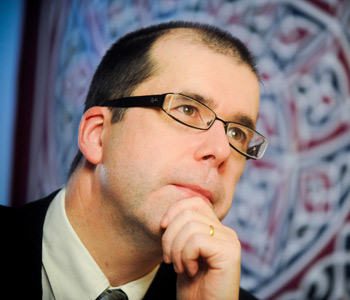Laura Skandera Trombley
Mark Twain’s Other Woman: The Hidden Story of His Final Years
Alfred A. Knopf
352 pages, 9 ¼ x 6 ¼ inches
ISBN 978 0307273444
An enduring mystery in Mark Twain’s life concerns the events of his last decade, 1900 to 1910.
Despite a multitude of published biographies, no one has determined exactly what took place during Twain’s final years and how those experiences affected him, both personally and professionally. Writers have speculated on whether his final decade was ruled by a growing misanthropy or whether he retained his keen sense of humor as he made his incisive social commentary.
The public version for nearly a century has been that Twain went to his death a beloved, wisecracking iconoclastic American, undeterred by life’s sorrows and challenges. However lives are complicated, Twain’s extraordinarily so. Long intrigued by the vagaries of Twain’s life, I sensed that there had to be more to the story than the carefully cultivated, homogenized version that had been intact for so long.
The key that turned the lock and helped reveal the answers to these questions and many more was Isabel Van Kleek Lyon. For almost one hundred years, Isabel Van Kleek Lyon has been the mystery woman in Mark Twain’s life. After the death of his wife, Olivia Langdon, in 1904, Twain spent the last six years of his life largely in Isabel’s company. To free himself from having to deal with professional and business matters, he willingly delegated the management of his schedule and finances to her. She was slavishly devoted to Twain: running the household staff, nursing him during his various illnesses, arranging amusements to keep boredom at bay, managing his increasingly unmanageable daughters, listening attentively as he read aloud what he’d written that day, acting as the gatekeeper to an enthralled public, and overseeing the construction of his final residence, “Stormfield.” And then something happened that led to the dramatic breakup of that relationship.
Mark Twain’s Other Woman is an exploration of those events. After Isabel had been summarily “fired,” Twain lived one last year, full of malice and terribly lonely. Mentally and emotionally he could never let her go. He finally delivered his coup de grace in a letter sent to his daughter Clara, branding his former companion “a liar, a forger, a thief, a hypocrite, a drunkard, a sneak, a humbug, a traitor, a conspirator, a filthy-minded & salacious slut pining for seduction.”
Yet despite the inordinate attention Twain gave her before his death, Isabel has remained a friendless ghost haunting the margins of Mark Twain’s biography. I wrote this book to lift the layers of what has come to be accepted as truth about Mark Twain’s life and to explore what actually existed in the beginning and what finally remained at the end. Indeed my account directly contradicts the well-established, genteel and genial image of one of America’s literary icons. This is a story that Mark Twain was determined no one would ever tell.

Writing biography is a challenge in that the talented biographer follows where the life leads her, not where she would like it to go. After all, the difference between fiction and fact is that fiction has to make sense.
Mark Twain biography remains rooted in an outworn tradition that too often rewards pedantry and tortured prose. In the beginning, Twain biography featured politically savvy scholars who avoided controversial topics to insulate themselves from criticism—both from the public who wanted to believe in their literary heroes as well as surviving family members all too ready to sue. Nowadays danger emanates from the opposite end of the academic continuum: biographies with the subtlety of smash-and-grab vandalism.
Nearly forty years ago, Twain biographer Hamlin Hill railed that it was time to challenge and change the entrenched trademark “Mark Twain” while wondering if it was not already too late. After all, people who mess with a folk savior who wrote “both a best-seller and an accepted masterpiece” and is still revered as “a hero, a prophet, a legend, a demigod,” present a tempting target. Right now, and for too many people, Mark Twain is either an animatronic statue at Disneyworld or the practiced Hal Holbrook.
A large part of the problem for interested readers is that Mark Twain is a major scholarly and commercial industry. Even during his life “Mark Twain” was recognized as a brand name as well as a pseudonym. Books about Mark Twain sell, much like books about the Civil War, Abraham Lincoln, fly-fishing, and vintage wines. My challenge as a biographer was to find a way to present new material about Twain without pandering to devotees or exploiting his commercial appeal.
Twain has been variously portrayed by past biographers as the damaged son of a castrating mother, a split personality, a womanizer, a gay man, an impotent man, a child-molester, a hypochondriac, a gold-digger, an abusive spouse, a neglectful father, a misogynist, and an alcoholic. With such a rich dysfunctional pedigree, if Twain had sung professionally, he’d be a ripe subject for one of VH1’s “Behind the Music” episodes.
With extensive archival research and many hundreds and notes, this biography will hopefully prove the exception. Yet, my goal has been to write for the public at large. Particularly for those individuals in the secular population who think that Twain is removed from their lives, or made of white marble, or (worse) boring. After thinking about Twain for over twenty years, my view is that he was a genius, the most gifted American writer of his or any era, and a man who led an enormous life full of unthinkable success and unbearable failure. In the end, he was ruthlessly human.
Writing biography is a challenge in that the talented biographer follows where the life leads her, not where she would like it to go. The evidence I uncovered about Twain’s final years took me places I could not have imagined. After all, the difference between fiction and fact is that fiction has to make sense.
Twain would not have wanted this story told and would have been litigiously furious if he were alive. After all, Twain understood that to last meant remaining an enigma and he wanted to influence (even from the grave) outcomes in all efforts to see him more clearly. Twain commented about those who would tell too much in a 1879 speech: “I don't mind what [they] say of me so long as they don't tell the truth about me. But when they descend to telling the truth about me I consider that this is taking an unfair advantage.”
Writing this biography took me a very long time, sixteen years. The reason: that is how long it took me to figure out the truth behind the fictionalized story Twain left about his life. After all he was our best fiction writer and it was hard to unravel his tale. What really happened the last decade of his life was a story he was determined no one would ever figure out. But I did.
The beginning of Chapter Two sets the stage for understanding what an unusual position Twain occupied at the end of his life.
Due to his longevity, Twain had almost become a lost figure, caught between the nineteenth and twentieth centuries—comfortable in neither. This tension contributed to the stresses and strains that surfaced in his family. Born two months prematurely on November 30, 1835, Twain’s birthplace was the hamlet of Florida, Missouri, located at the fork of the Salt River. Red-haired Samuel Langhorne Clemens arrived to his parents in a tiny two-bedroom, rented cabin with an outdoor lean-to kitchen. By the fall of 1905, at age sixty-nine, he had become a wealthy resident of lower Manhattan, New York City.
New York City in 1905 boasted the world’s busiest harbor, the biggest ships and longest bridges, the worst slums and overwhelming prosperity. There were elevated trains that crossed rivers and twenty miles of newly completed New York subway with the fare costing just a nickel. Traffic was thick with people, pushcarts, horses, cars and trolleys all jostling for a place in the crowded streets. The largest conglomeration of millionaires in history, who had accumulated gigantic tax-free fortunes, lived in massive homes on tree-lined boulevards. An enormous wave of immigrants from Eastern Europe and Italy was passing through Ellis Island, changing the city’s ethnic make-up and culture and creating tremendous social and political stresses. New York was the largest Jewish city in the world, the largest Irish city, one of the largest German cities, and home to more than 700,000 Russians. This was Mark Twain’s city and he was its most celebrated citizen, popularly recognized as the “Belle of New York.”
Twain belonged to the world and was the first global celebrity. On December 6, 1905 he celebrated his seventieth birthday at Delmonico’s Restaurant with 170 of his friends and fellow writers. President Theodore Roosevelt sent a speech to be read in his absence, pointing out that Twain “is one of the citizens whom all Americans should delight to honor, for he has rendered a great and peculiar service to America, and his writings, though such as no one but an American could have written, yet emphatically come within that small list which are written for no particular country, but for all countries, and which are not merely written for the time being, but have an abiding and permanent value.” After a banquet lasting five hours, with fifteen speeches given and nine poems read, those in attendance were given a foot-high plaster bust of the honoree. By the close of the evening, there were 171 Mark Twains in the room. This unschooled son of Missouri had become as big as New York City.

In the beginning, Twain biography featured politically savvy scholars who avoided controversial topics to insulate themselves from criticism—both from the public who wanted to believe in their literary heroes as well as surviving family members all too ready to sue. Nowadays danger emanates from the opposite end of the academic continuum: biographies with the subtlety of smash-and-grab vandalism.
My ambition for this biography is to encourage a reappraisal of Mark Twain in this centennial year of his death. For too long, the public version of Twain has been the image of a calcified, genteel, white statue that apparently was free of the worries that constitute the human condition. In fact, Twain was utterly human in his struggles as a spouse and parent. At the end of his life, he gave free rein to his feelings of rage and inadequacy, and in his frantic efforts to establish his legacy he reveals his narcissism and insecurity.
If anything, Twain’s literary genius lay in his ability to sublimely capture our common humanity and make us realize that even in the midst of horrendous social evils, it was possible for an unschooled, poor, southern boy to do the right thing when it came to protecting Jim, the only adult who had ever treated him with kindness.
It is time to make Twain human again. The purpose of Mark Twain’s Other Woman is to lift the layers of what has come to be accepted as truth about Mark Twain’s life and to explore what actually existed in the beginning and what finally remained at the end.




We don't put paywalls. We don't distract you with ads. We don't sell your data.
Please help to keep this running!